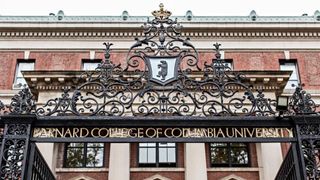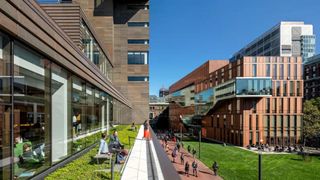We chat with Sian Leah Beilock, President of Barnard College, Columbia University, about revamping the curriculum for a fully remote fall.
“We made a big technology investment—our classrooms are now tech-enabled and we set up teaching studios for demonstrations and science labs," says Beilock. "We are really trying to think outside the box, not only with technology but how to engage students in remote learning through curriculum adjustments. As a cognitive scientist by training, it’s important to model that flexibility.”
Last fall, Barnard launched the Center for Engaged Pedagogy to support both faculty and students, and it has been critical for remote learning. Melanie Hibbert—Ed.D., Director of IMATS (Instructional Media and Technology Services) and the Sloate Media Center at Barnard College—has been instrumental in preparing faculty and overseeing the new teaching studios used for filming labs and interactive classrooms used for remote learning. IMATS is also assisting individual professors with their specific needs (e.g. a custom chemistry lab app around lab procedures) and helps instructors with Zoom and CourseWorks.
“One thing we know from research is that in remote settings, shorter, intensive courses can be better for learning," says Beilock. "The Center helped our faculty adjust and this fall about a third of our classes will be taught in half-semester blocks. They helped faculty think about content differently. It’s less about the nuts and bolts of Zoom and more about how do we deliver engaging content and think about academic excellence now.”
Content for the times
Content delivery philosophies weren’t the only adjustments made.
“As COVID-19 challenges continued, and the heightened awareness of anti-racism came about, we saw young people really involved in the movements—whether it was tutoring kids of frontline workers or taking part in marches," says Beilock. "We started thinking about how we could meet them where they were with a curriculum that was addressing the current times and helping them affect the change they wanted. It’s something inherent in Barnard, we’re of the city not in the city, the classroom is not just four walls anymore."
All first-year students are required to take Big Problems, Making Sense of 2020, a new remote course. Guest speakers will give presentations and then students will break out in small groups of 20 or less, which are led by specially trained upper class students and offer a chance for first-year students to interact with their older counterparts. The idea is for students to interrogate the current times through a variety of lenses.
This is yet another silver lining moment, with technology making this impactful course possible.
“Because it is distance learning, we can bring in really high-profile activists and medical practitioners from around the world and allow students to have contact with them," says Beilock. "They learn from their experiences and then bring that to their small discussion groups to absorb. It’s so popular we even have alumnae patching in to listen to the lectures, some will even be giving talks. It has enhanced our global Alumnae Circle program, which gives local access to students currently studying from their home communities.”

If you build it, they will record
Two new spaces on Barnard’s campus within The Milstein Center for Teaching and Learning have been dedicated to the recording and delivery of lectures. This newly designed production studio features a light grid, audio booth, and green screen, and is open for reservations.
The set-up includes: two large monitors so you can see both Zoom participants and presentation content; camera/audio input, and a computer; a whiteboard camera system; a document camera; and professional studio light. Recent upgrades to classroom spaces allow for live-streaming, which will enable instructors to simultaneously work with students in-person and online.
The majority of larger classrooms have been upgraded to include wall-mounted instructor and audience facing pan-tilt-zoom (PTZ) cameras. The instructor-facing camera has presets so it can record an instructor at a podium, the instructor plus a whiteboard or blackboard, or a wide angle shot. These presets, as well as manual PTZ control, can be selected through the AV touch panel. In addition, these rooms have newly installed ceiling microphones for full room audio coverage.
Seminar rooms have also been upgraded to include a 120° camera that has voice tracking capabilities. These cameras will automatically focus on the speaker after a few seconds of speaking.
Camera angles can also be controlled by remote control or smartphone app, and include microphones with a 12-foot range.
IMATS collaborates with Barnard College Information Technology (BCIT) and Columbia University IT (CUIT) to support a wide range of software and apps. Canvas as a learning management system and Zoom are broadly used. Innovative third-party applications are being piloted and implemented into Canvas, such as Perusall, Hypothe.sis, and Padlet.
Pro tip
“For us, our faculty were so excited so we gave them the support and let them run," says Beilock. "That’s the crucial step. Engage the faculty and let them lead. They are the experts and they have so much to offer.”
Tech tools
- CAM530 12X PTZ camera USB, HDMI & RS232
- SCT Wall/ceiling mount
- Crestron OFE Crestron HDMI Extender in existing Extron MediaPort
- Crestron Wall Plate DigitalMedia 8G+® Transmitter 200, White Textured
- 1 Crestron 4K DigitalMedia 8G+® Receiver & Room Controller 1
- 1 OFE OFE Room PC- Zoom soft Codec in Podium
- Shure Ceiling Mic Array, Intellimix, White, 24in tile form factor
- AVer Cam530 and Vaddio Roboshot 12E
- Shure MXA910 Ceiling mics
- Logitech MeetUp
- Logitech Rally PTZ Camera
- Elmo MX-P2 document camera


